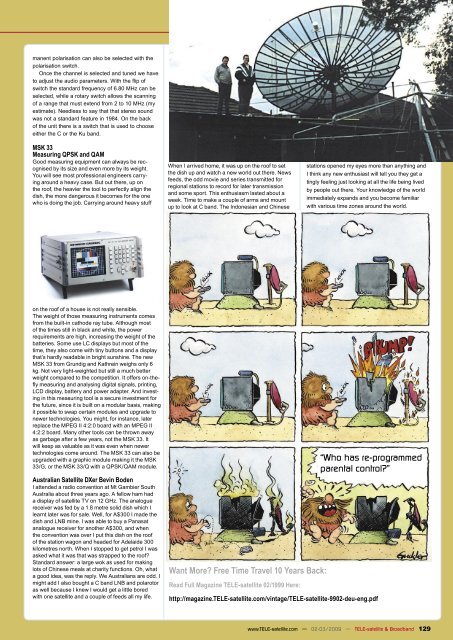02-03 - TELE-satellite International Magazine
02-03 - TELE-satellite International Magazine
02-03 - TELE-satellite International Magazine
Create successful ePaper yourself
Turn your PDF publications into a flip-book with our unique Google optimized e-Paper software.
manent polarisation can also be selected with the<br />
polarisation switch.<br />
Once the channel is selected and tuned we have<br />
to adjust the audio parameters. With the flip of<br />
switch the standard frequency of 6.80 MHz can be<br />
selected, while a rotary switch allows the scanning<br />
of a range that must extend from 2 to 10 MHz (my<br />
estimate). Needless to say that that stereo sound<br />
was not a standard feature in 1984. On the back<br />
of the unit there is a switch that is used to choose<br />
either the C or the Ku band.<br />
MSK 33<br />
Measuring QPSK and QAM<br />
Good measuring equipment can always be recognised<br />
by its size and even more by its weight.<br />
You will see most professional engineers carrying<br />
around a heavy case. But out there, up on<br />
the roof, the heavier the tool to perfectly align the<br />
dish, the more dangerous it becomes for the one<br />
who is doing the job. Carrying around heavy stuff<br />
on the roof of a house is not really sensible.<br />
The weight of those measuring instruments comes<br />
from the built-in cathode ray tube. Although most<br />
of the times still in black and white, the power<br />
requirements are high, increasing the weight of the<br />
batteries. Some use LC displays but most of the<br />
time, they also come with tiny buttons and a display<br />
that’s hardly readable in bright sunshine. The new<br />
MSK 33 from Grundig and Kathrein weighs only 6<br />
kg. Not very light-weighted but still a much better<br />
weight compared to the competition. It offers on-thefly<br />
measuring and analysing digital signals, printing,<br />
LCD display, battery and power adapter. And investing<br />
in this measuring tool is a secure investment for<br />
the future, since it is built on a modular basis, making<br />
it possible to swap certain modules and upgrade to<br />
newer technologies. You might, for instance, later<br />
replace the MPEG II 4:2:0 board with an MPEG II<br />
4:2:2 board. Many other tools can be thrown away<br />
as garbage after a few years, not the MSK 33. It<br />
will keep as valuable as it was even when newer<br />
technologies come around. The MSK 33 can also be<br />
upgraded with a graphic module making it the MSK<br />
33/G, or the MSK 33/Q with a QPSK/QAM module.<br />
Australian Satellite DXer Bevin Boden<br />
I attended a radio convention at Mt Gambier South<br />
Australia about three years ago. A fellow ham had<br />
a display of <strong>satellite</strong> TV on 12 GHz. The analogue<br />
receiver was fed by a 1.8 metre solid dish which I<br />
learnt later was for sale. Well, for A$300 I made the<br />
dish and LNB mine. I was able to buy a Panasat<br />
analogue receiver for another A$300, and when<br />
the convention was over I put this dish on the roof<br />
of the station wagon and headed for Adelaide 300<br />
kilometres north. When I stopped to get petrol I was<br />
asked what it was that was strapped to the roof?<br />
Standard answer: a large wok as used for making<br />
lots of Chinese meals at charity functions. Oh, what<br />
a good idea, was the reply. We Australians are odd. I<br />
might add I also bought a C band LNB and polarotor<br />
as well because I knew I would get a little bored<br />
with one <strong>satellite</strong> and a couple of feeds all my life.<br />
When I arrived home, it was up on the roof to set<br />
the dish up and watch a new world out there. News<br />
feeds, the odd movie and series transmitted for<br />
regional stations to record for later transmission<br />
and some sport. This enthusiasm lasted about a<br />
week. Time to make a couple of arms and mount<br />
up to look at C band. The Indonesian and Chinese<br />
Want More? Free Time Travel 10 Years Back:<br />
Read Full <strong>Magazine</strong> <strong>TELE</strong>-<strong>satellite</strong> <strong>02</strong>/1999 Here:<br />
stations opened my eyes more than anything and<br />
I think any new enthusiast will tell you they get a<br />
tingly feeling just looking at all the life being lived<br />
by people out there. Your knowledge of the world<br />
immediately expands and you become familiar<br />
with various time zones around the world.<br />
“Who has re-programmed<br />
parental control?”<br />
http://magazine.<strong>TELE</strong>-<strong>satellite</strong>.com/vintage/<strong>TELE</strong>-<strong>satellite</strong>-99<strong>02</strong>-deu-eng.pdf<br />
www.<strong>TELE</strong>-<strong>satellite</strong>.com — <strong>02</strong>-<strong>03</strong>/2009 — <strong>TELE</strong>-<strong>satellite</strong> & Broadband 129
















